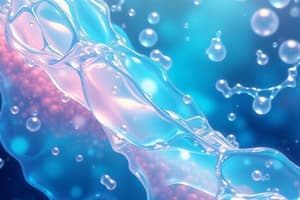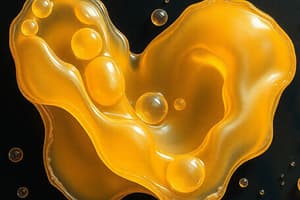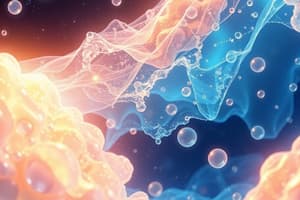Podcast
Questions and Answers
Which pH condition resulted in the highest R2 value for the first order kinetics of CS1Glut0.4?
Which pH condition resulted in the highest R2 value for the first order kinetics of CS1Glut0.4?
- pH 10.5
- Temp. 40°C
- pH 7 (correct)
- pH 2.5
What parameter corresponds to the lowest K2 value in the second order kinetics for CS1Glut0.2?
What parameter corresponds to the lowest K2 value in the second order kinetics for CS1Glut0.2?
- Temp. 20°C (correct)
- 0.1M NaCl
- Temp. 40°C
- pH 10.5
Which ion concentration exhibited the highest Seq(obtained) value for CS1Glut0.4 at pH 7?
Which ion concentration exhibited the highest Seq(obtained) value for CS1Glut0.4 at pH 7?
- 0.001M NaCl
- 0.01M NaCl
- 0.1M CaCl2
- 0.1M NaCl (correct)
In the context of chitosan hydrogels, which temperature condition demonstrated the highest R2 value for the second order kinetics?
In the context of chitosan hydrogels, which temperature condition demonstrated the highest R2 value for the second order kinetics?
Which of the following showed a significant increase in Seq(calculated) for the second order kinetics of CS1Glut0.2?
Which of the following showed a significant increase in Seq(calculated) for the second order kinetics of CS1Glut0.2?
What is the first model described in relation to solvent distribution into the gel matrix?
What is the first model described in relation to solvent distribution into the gel matrix?
What type of behavior do sigmoidal swelling curves often describe?
What type of behavior do sigmoidal swelling curves often describe?
In the synthesis of uncrosslinked CS beads, what is used as a precipitation bath?
In the synthesis of uncrosslinked CS beads, what is used as a precipitation bath?
What differentiates the synthesis of uncrosslinked CS films from CS beads?
What differentiates the synthesis of uncrosslinked CS films from CS beads?
What is a notable characteristic of the swelling curve according to the models discussed?
What is a notable characteristic of the swelling curve according to the models discussed?
What aspect of CS hydrogels has seen limited literature availability?
What aspect of CS hydrogels has seen limited literature availability?
During the synthesis of CS hydrogels, what is mixed with chitosan to create a uniform solution?
During the synthesis of CS hydrogels, what is mixed with chitosan to create a uniform solution?
What is the primary reason for the interest in shape-changing hydrogels?
What is the primary reason for the interest in shape-changing hydrogels?
What is the role of 'n' in diffusion analysis?
What is the role of 'n' in diffusion analysis?
How can the diffusion coefficient 'D' for cylindrical hydrogels be calculated according to Fick's second law?
How can the diffusion coefficient 'D' for cylindrical hydrogels be calculated according to Fick's second law?
At what solvent entry percentage should the ln F versus ln t graph be plotted for data collection?
At what solvent entry percentage should the ln F versus ln t graph be plotted for data collection?
What type of atmosphere is used during the thermogravimetric analysis of crosslinked CS hydrogels?
What type of atmosphere is used during the thermogravimetric analysis of crosslinked CS hydrogels?
At what temperature range is the maximum weight loss of about 43% observed in the polymeric network?
At what temperature range is the maximum weight loss of about 43% observed in the polymeric network?
Which thermal analysis method assesses the thermal properties of the hydrogels?
Which thermal analysis method assesses the thermal properties of the hydrogels?
What is the temperature range maintained during the thermogravimetric analysis?
What is the temperature range maintained during the thermogravimetric analysis?
What is the primary cause of weight loss in the first stage of polymer decomposition?
What is the primary cause of weight loss in the first stage of polymer decomposition?
Peleg's empirical equation is used for what purpose in material research?
Peleg's empirical equation is used for what purpose in material research?
Which of the following modifications generally leads to decreased thermal stability of chitosan (CS)?
Which of the following modifications generally leads to decreased thermal stability of chitosan (CS)?
What weight loss percentage is approximately observed at 160°C?
What weight loss percentage is approximately observed at 160°C?
What concentration of glutaraldehyde is used in synthesizing the disc shaped hydrogels?
What concentration of glutaraldehyde is used in synthesizing the disc shaped hydrogels?
What significant changes occur to the molecules between 225°C and 298°C?
What significant changes occur to the molecules between 225°C and 298°C?
What is the maximum heating rate used during the DSC analysis of hydrogels?
What is the maximum heating rate used during the DSC analysis of hydrogels?
What effect does chemical modification with glutaraldehyde and sulfuric acid have on chitosan (CS)?
What effect does chemical modification with glutaraldehyde and sulfuric acid have on chitosan (CS)?
Which type of hydrogel shapes are mentioned as part of the study?
Which type of hydrogel shapes are mentioned as part of the study?
Which factors influence the amount of weight loss during polymer decomposition?
Which factors influence the amount of weight loss during polymer decomposition?
Which of the following acids were mentioned as modifying agents for chitosan (CS)?
Which of the following acids were mentioned as modifying agents for chitosan (CS)?
What would be the consequence of a chemical modification that decreases thermal stability in chitosan (CS)?
What would be the consequence of a chemical modification that decreases thermal stability in chitosan (CS)?
What is the effective pKa of chitosan (CS) as mentioned in the content?
What is the effective pKa of chitosan (CS) as mentioned in the content?
How does the swelling value of uncrosslinked CS beads at pH 7 compare to other studies?
How does the swelling value of uncrosslinked CS beads at pH 7 compare to other studies?
What happens to the swelling behavior of CS when the pH is alkaline?
What happens to the swelling behavior of CS when the pH is alkaline?
Which equation represents the exponential association model for swelling?
Which equation represents the exponential association model for swelling?
What is the best swelling percentage reported for a flat 2D shaped film at pH 7?
What is the best swelling percentage reported for a flat 2D shaped film at pH 7?
What occurs during absorption according to the equations provided?
What occurs during absorption according to the equations provided?
What describes the behavior of chitosan in acidic solutions?
What describes the behavior of chitosan in acidic solutions?
When converting the exponential model equation to a straight-line equation, what is the main purpose?
When converting the exponential model equation to a straight-line equation, what is the main purpose?
What is the observed swelling behavior of CS beads at pH 7 referenced from another study?
What is the observed swelling behavior of CS beads at pH 7 referenced from another study?
What is indicated by the k1 and k2 constants in the swelling equations?
What is indicated by the k1 and k2 constants in the swelling equations?
Flashcards are hidden until you start studying
Study Notes
Swelling
- Two models describe the swelling of chitosan hydrogels.
- The first model describes the swelling fraction increasing linearly with the square root of time.
- This model is only valid for smaller swelling fractions.
- The second model focuses on the relationship between stress gradient and swelling/network expansion.
- These models lack the ability to describe sigmoidal swelling curves.
- Sigmoidal swelling curves often represent non-Fickian diffusion behavior.
- Fickian diffusion correctly describes sigmoidal swelling behavior when considering the movement of the gel surface.
Chitosan Hydrogels Synthesis
- Chitosan hydrogels can exist in different shapes including beads, films, and discs.
- Uncrosslinked chitosan hydrogels are synthesized by precipitating chitosan (CS) in sodium hydroxide (NaOH).
- The chitosan and acetic acid mixture forms beads in a precipitation bath.
- In a petridish, the mixture dries to form a film.
- Glutaraldehyde is used as a crosslinker for CS in disc shaped hydrogels.
- CS can be crosslinked using other methodologies such as irradiation techniques.
Chitosan Hydrogel Swelling Ability
- Chitosan beads display a swelling of 100-200% at pH 7.
- Chitosan beads show lower swelling in alkaline pH.
- Chitosan is soluble below its pKa of 6-6.5 and insoluble above it.
- Chitosan films exhibit higher swelling than beads.
- Uncrosslinked chitosan film swelling is about 3000% at pH 7.
- This film is susceptible to dissolution in acidic conditions, resulting in a 3D tubular shape in neutral condition.
Modeling of Water Absorption in Hydrogels
- Peleg's absorption model is used to describe water absorption.
- This model is expressed using the following equation:
S = So ± k1/(1 + k2*t) - This equation uses two parameters, k1 and k2 which represent kinetic and characteristic constants.
- The "+" sign is used for water absorption and "-" is used for desorption.
- The Exponential association model is used for describing exponential growth and decay.
- This model is expressed by the following equation:
S = [1−exp(-kR2t)] - The kinetic constant in this model is kR2.
Diffusion Coefficient Equation
- The diffusion coefficient for cylindrical hydrogels can be calculated using the following equation:
D = k1/πr^2 (4/n) - The equation is derived from Fick's second law of diffusion.
- D represents the diffusion coefficient (m^2/s)
- r represents the radius of the swollen hydrogel (meter)
- k1 is kinetic constant and n is the diffusion exponent.
Thermogravimetric Analysis of CS hydrogels
- Thermal properties of CS hydrogels are assessed using thermogravimetric analysis (TGA).
- Three stages of weight loss are observed during thermal decomposition.
- The first stage mainly consists of water evaporation from the hydrogels network.
- The second stage involves decomposition of CS and conversion of complex molecules into simpler ones like acetic acid and lower fatty acids.
- The third stage continues the decomposition of remaining fragments.
- Chemical modification generally leads to a decrease in thermal stability of CS.
Kinetics of Water Absorption
- Two kinetic models are used to describe water absorption: First order and second order kinetics.
- The R2 values (correlation coefficient) for both models are given in Tables 2 and 3.
- The kinetic constants k1, k2 and R2 values are presented for hydrogels at different pH values, temperatures, and in the presence of different salts.
Diffusion Exponent
- The diffusion exponents values are given in Table 4.
- These values provide insights into the diffusion mechanism of water in the hydrogels.
Studying That Suits You
Use AI to generate personalized quizzes and flashcards to suit your learning preferences.




